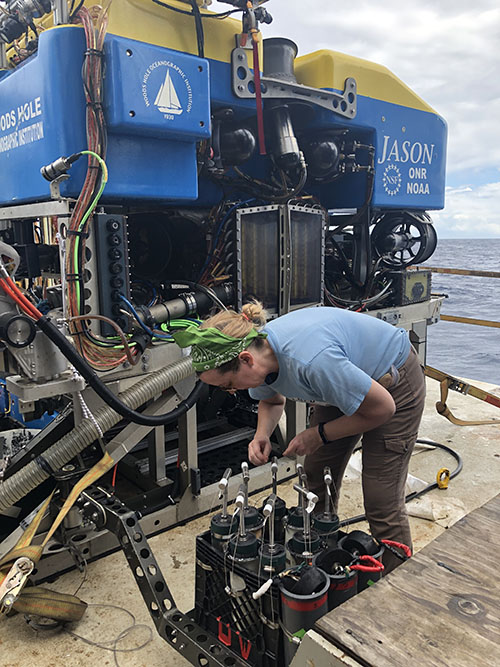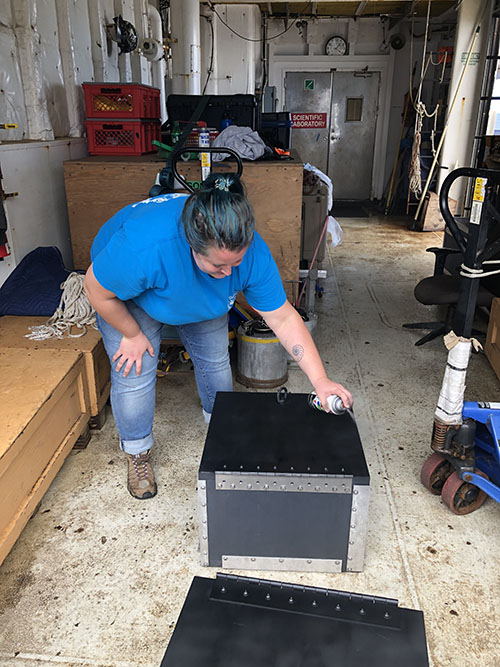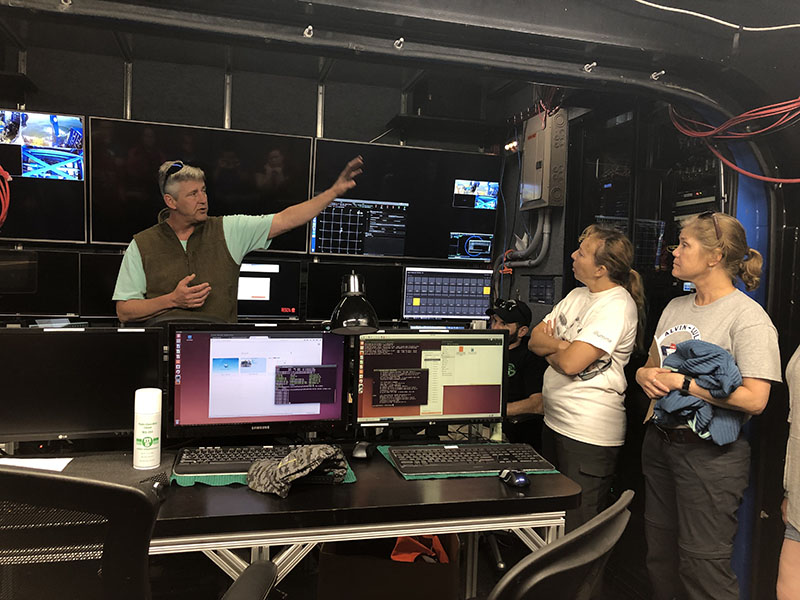
By Ken Kostel, Woods Hole Oceanographic Institution

On this mission, ROV Jason will be used as a single-body system. Operating in single-body mode will allow for the ROV team to have greater operational flexibility in the high current environments of the Gulf Stream. Image courtesy of Tom Kleindinst, Woods Hole Oceanographic Institution. Download larger version (jpg, 9.7 MB).
In advance of DEEP SEARCH 2019’s first remotely operated vehicle (ROV) dive today, Woods Hole Oceanographic Institution (WHOI) has shared the following overview about ROV Jason. Check back soon for our impressions of the first dive of the cruise. We’ll be diving at Richardson Hills and are expecting to see some spectacular coral habitats!
Jason is an ROV system designed and built by WHOI’s National Deep Submergence Laboratory and funded by the National Science Foundation. Its design gives scientists access to most of the globe’s seafloor, often for days at a time, without leaving the deck of a ship.
The vehicle can operate as either a two-body (with ROV Medea) or a single-body system, depending on mission requirements. A 10-kilometer (6-mile) reinforced fiber-optic cable delivers electrical power and control signals from the ship to the vehicle and returns data and live video imagery throughout a dive. When Medea is used, it acts as a “shock absorber” shielding Jason from the movement of the ship and cable. For the DEEP SEARCH mission, Jason will be operated in single-body mode with a series of floats attached to the cable to dampen the influence of the surface swell.
Jason is equipped with sonars, video and still imaging systems, lighting, and a flexible payload of sensors and sampling systems. The vehicle’s manipulator arms collect samples just by picking them up, or by deploying sampling gear provided by the science team, such as push cores and mussel pots. The samples are then placed in the vehicle’s basket or on “elevator” platforms that float samples to the surface, permitting Jason to stay submerged for as much as a week at a time.

Before every dive, the DEEP SEARCH team will work with the Jason operators to decide on a plan for the sampling basket. Scientists bring their own specialized sampling gear with them, and the Jason team secures the gear on the basket before every dive. Here, Amanda Demopoulos prepares her sediment push cores before the first dive. Image courtesy of DEEP SEARCH 2019 - BOEM, USGS, NOAA. Download larger version (jpg, 5.5 MB).

Alexis Weinnig spray paints the top of the bioboxes that will be used to safely store live coral samples collected during dives. The black matte paint helps to reduce glare that could interfere with the video cameras mounted above the sample basket. Image courtesy of DEEP SEARCH 2019 - BOEM, USGS, NOAA. Download larger version (jpg, 5.8 MB).
Pilots and scientists work from the ship, in a dedicated control room that travels with Jason, to monitor data and video feeds. Jason has six thrusters that give its pilots precise control along three axes, as well as almost any orientation along those axes, and it can also hover a meter above the seafloor, nose into deep crevices, or pluck samples from a spot pinpointed by scientists on the ship.

Jason Expedition Leader Tito Collasius gives the science team an orientation to the ROV control room. During dives, three members of the science team will staff the control room in four-hour shifts as watch lead, data logger, and video logger. The Jason team also operates the vehicle with a staff of three: a navigator, a pilot, and an engineer. Image courtesy of DEEP SEARCH 2019 - BOEM, USGS, NOAA. Download larger version (jpg, 4.7 MB).
The first Jason began its career in 1988 and retired in 2001. In 2002, a new, second-generation Jason made its debut and has successfully completed over a thousand dives to deep-sea sites in the Pacific, Atlantic, and Indian Oceans. In 2010, it provided the first live look at an exploding underwater volcano.
Medea and Jason are designed to operate to a maximum depth of 6,500 meters (21,385 feet), which gives them access to 98 percent of the seafloor and they can operate from a wide range of vessels. In 2016, it completed a major overhaul , which resulted in a sturdier, more flexible vehicle that includes:
Recent expeditions have taken Jason to the Havre volcano on the seafloor off the coast of New Zealand, Lost City on the Mid-Atlantic Rise, and is a regular part of activity at the Ocean Observatories Initiative Cabled Array off the coast of Oregon. In addition, the vehicle is used increasingly with the autonomous underwater vehicle (AUV) Sentry to cover more seafloor more efficiently and to make more targeted explorations of seafloor features and phenomena.